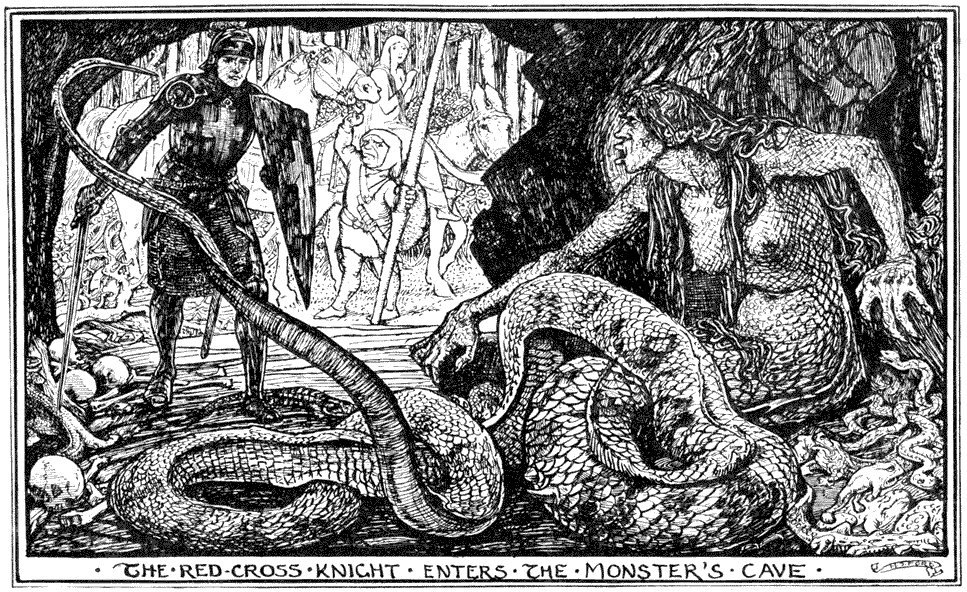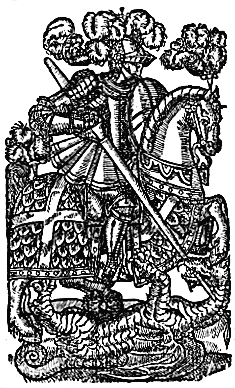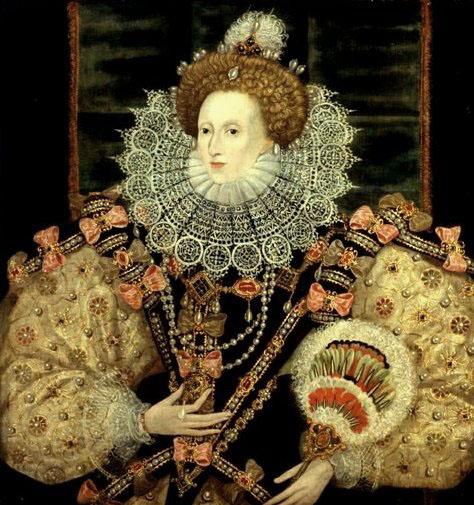I like to lead into the poem with this anecdote, to suggest to my students that this poem is challenging and that they might not like it at the beginning because of the difficulty of its language, but that this might be the start of a lifetime of enjoyment and pleasure for them if they are willing to give it a chance. Basically, to continue the drug analogy: I push Spenser on them by making them take that first hit. I am a terrible influence.
But where to start?
In teaching Book I, I like to start very slowly at first, spending an entire day on just the first three stanzas of Canto I.
A Gentle Knight was pricking on the plaine,
Y cladd in mightie armes and siluer shielde,
Wherein old dints of deepe wounds did remaine,
The cruell markes of many a bloudy fielde;
Yet armes till that time did he neuer wield:
His angry steede did chide his foming bitt,
As much disdayning to the curbe to yield:
Full iolly knight he seemd, and faire did sitt,
As one for knightly giusts and fierce encounters fitt.
This stanza presents Redcrosse as a chivalric knight. He is setting out on an adventure. In Spenser's description of the knight "pricking" on the plain, we can see a phallic pun and we know that Redcrosse is out to prove his manliness. I ask my students, what kind of person is Redcrosse? If this were a movie and you were a casting director, what actor would you cast as Redcrosse?
They almost always start out with someone uber macho, like Russell Crowe, so I direct them to take another look at that amazing fifth line, where the stanza starts to nuance and pull back from what it's already stated. What does the fifth line mean? What does it mean that his horse is foaming at the bit? [Answer: the horse is a metonym for its rider; both are super anxious to get started on this journey.] This helps students to see that Redcrosse hasn't yet proved himself, and that this journey is the occasion for him to do so. They then recast Redcrosse as Zac Efron, and my heart sings for joy that they have such amazing senses of humor.
But on his brest a bloudie Crosse he bore,
The deare remembrance of his dying Lord,
For whose sweete sake that glorious badge he wore,
And dead as liuing euer him ador'd:
Vpon his shield the like was also scor'd,
For soueraine hope, which in his helpe he had:
Right faithfull true he was in deede and word,
But of his cheere did seeme too solemne sad;
Yet nothing did he dread, but euer was ydrad.
The second stanza establishes the Christian allegory. I ask my students the following questions about this stanza: what is on his shield? How is Redcrosse now described?
In this stanza, Spenser establishes that Redcrosse is a symbol for Holiness… or perhaps more specifically, a person who want to learn how to be holy.
I have found that it is important to note to students that this poem is both a more general allegory about holiness and goodness that could apply to all sinners, and a specific allegory about Protestants learning to resist the tempting seduction of Catholic images. Usually this requires a lot of input from me here, because students don't always have a keen grasp of the history of the Protestant Reformation. It's worth it to take time here, because these issues return later in the book--with a vengeance!
Vpon a great aduenture he was bond,
That greatest Gloriana to him gaue,
That greatest Glorious Queene of Faerie lond,
To winne him worship, and her grace to haue,
Which of all earthly things he most did craue;
And euer as he rode, his hart did earne
To proue his puissance in battell braue
Vpon his foe, and his new force to learne;
Vpon his foe, a Dragon horrible and stearne.
Stanza three reveals the extent to which the poem is also an allegory about Queen Elizabeth’s court. Like Redcrosse, Spenser hopes to curry favor with a queen over the course of this adventure. I ask my students the following questions to get them to try to see connections between Gloriana and Queen Elizabeth:
- According to stanza three, whom does Redcrosse hope to impress?
- What goal does he have in mind as he embarks on his journey?
- In the "Letter to Ralegh," Spenser states that Gloriana, the titular Fairy Queen, is a mirror for Queen Elizabeth. How is this important here in the opening stanzas?
From there, I go in one of two directions. If I only have a short amount of time, then I focus on the stanzas up through when Redcrosse and Error fight against each other (see the image in the lede above). If I am going to spend more time on the poem, I teach excerpts from Book I, really focusing on Redcrosse's development and editing out the cantos when Una is by herself.
I will post more discussion questions for later cantos in Book I in another post, but for now I'll wrap up with some discussion questions for the episode wherein Redcrosse fights Error:
- Redcrosse’s encounter with Error is the first of the important battle in the poem. Read this segment carefully (stanzas 14-26). What does Error look like? Does she have any kids? What are they like? How do we read her body allegorically? Which allegory are we reading for in these stanzas and how do you know?
- What happens when Error attacks? How does Redcrosse get free of the first attack (stanza 19)?
- What does Error vomit and what is the significance of that? How does she die? What happens to her offspring when she dies?
- Does Redcrosse “really” win in the battle against Error, or does he succeed in spite of himself? Is Error an outward manifestation of Redcrosse’s inward spiritual state?
Spenser's Faerie Queene is a rewarding text that is not commonly taught in high schools, but it could be, especially if it is used as a way to teach the concept of allegory.





 RSS Feed
RSS Feed